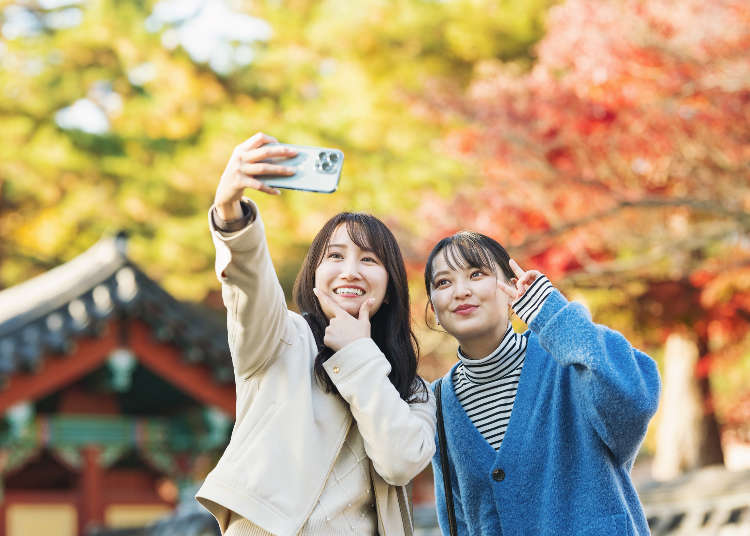
Autumn in Japan isn’t just about fiery maples and golden ginkgo trees. As the summer heat fades, the season ushers in lively festivals, bountiful harvests, seasonal delicacies, dazzling fireworks, and bustling markets. Each year, countless travelers plan trips specifically to admire the autumn foliage. The colors start in Hokkaido, gradually moving southward until Tokyo, Osaka, and Kyoto are all transformed into a sea of red and gold, with the entire country wrapped in the beauty of the season.
To help you make the most of your trip, we’ve put together key holiday dates, top foliage spots, and details on autumn festivals. Whether you’re after a quick getaway or a deeper dive into Japan’s traditions and culture, this guide is the perfect place to start.
Main image: PIXTA
- Table of Contents
-
- Japan’s National Holidays & Annual Festivals (Autumn–Winter)
- Recommended Autumn Activities: Foliage, Mid-Autumn Festival & Autumn Festivals
- Mid-Autumn Festival: Full Moon, Dumplings & the Romance of Autumn Nights
- Autumn Festivals: From Moon Viewing to Jidai Matsuri, Celebrating Japan’s Harvest Traditions
Japan’s National Holidays & Annual Festivals (Autumn–Winter)
Autumn Holidays in Japan: September–November 2025
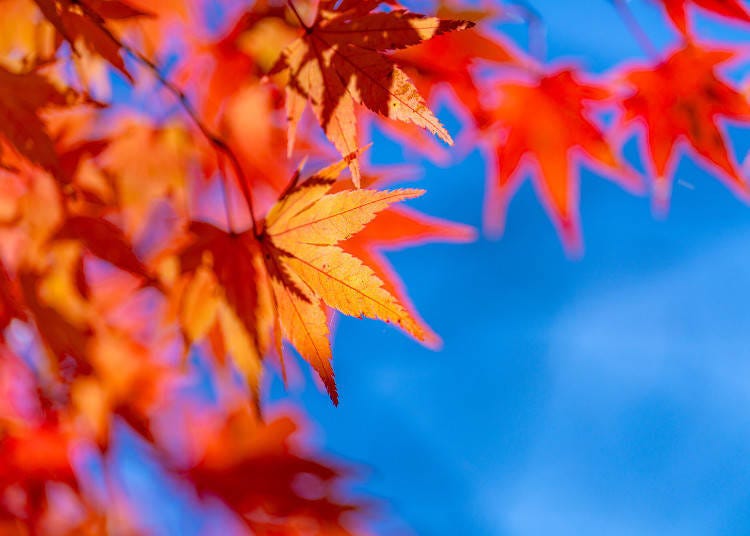
September 2025
September 15: Respect for the Aged Day (Keirō no Hi)
This national holiday began in a small town in Hyogo Prefecture as a way to honor the wisdom of elders. It later spread across Japan and became an official public holiday. Today, families often share a meal together, while younger generations give gifts such as health-related devices—massage chairs, blood pressure monitors, and more—to show appreciation. The holiday reflects Japan’s deep respect for seniors and the strong ties between generations.
September 23: Autumnal Equinox Day (Shūbun no Hi)
On this day, daytime and nighttime are almost equal, symbolizing the balance of yin and yang. In Japan, it has long been regarded as a spiritual time closest to the afterlife, prompting visits to family graves and offerings to ancestors. People prepare ohagi (sweet rice cakes with red bean paste) alongside green tea, expressing gratitude and remembrance. The day also marks the transition from summer’s heat to the cool, fruitful autumn season, reminding people of both life’s cycles and nature’s abundance.
Public Holidays in Other Countries (September 2025)
・United States: Labor Day – September 1
・Australia: Labour Day (WA) – September 29
・Philippines: National Heroes Day – September 1
October 2025
October 13: Sports Day (Supōtsu no Hi)
Now held on the second Monday of October, this holiday was originally established to commemorate the 1964 Tokyo Olympics and was then called “Health and Sports Day.” It was later renamed Supōtsu no Hi, becoming Japan’s first national holiday written in katakana. In 2000, the government introduced the “Happy Monday System,” moving it to Monday to create a long weekend. Beyond honoring Olympic ideals, the day promotes sports for all, encouraging people to enjoy exercise not just as competition but as a way to stay balanced, healthy, and active.
Public Holidays in Other Countries (October 2025)
・United States: Columbus Day – October 13
・Singapore: Deepavali – October 20
・Australia: Labour Day (ACT, NSW, SA) – October 6
November 2025
November 3: Culture Day (Bunka no Hi)
Originally the birthday of Emperor Meiji, this holiday was later dedicated to “cherishing freedom and peace while promoting culture.” Each year on this day, the Japanese government awards the Order of Culture to individuals with outstanding achievements in the arts, academia, and related fields. Many museums and galleries also open their doors for free, making it an ideal opportunity for the public to engage with art and culture. More than just a holiday, Culture Day encourages reflection, appreciation, and immersion in creativity, making it a perfect day to explore and enjoy cultural experiences.
November 23: Labor Thanksgiving Day (Kinrō Kansha no Hi)
In 2025, Labor Thanksgiving Day falls on November 23, with a substitute holiday on November 24, creating a three-day weekend. The holiday traces back to the Asuka period’s Niinamesai ritual, in which the emperor offered the first harvest of rice to the gods in gratitude. Over time, it evolved into today’s Labor Thanksgiving Day, honoring workers and their contributions. People often express thanks to colleagues and family, while events and exhibitions across Japan highlight the meaning of labor and daily life. Many also take short trips or relax in hot springs, making it both a day of appreciation and renewal.
Public Holidays in Other Countries (November 2025)
・United States: Veterans Day – November 11; Thanksgiving Day – November 27
・Australia: Melbourne Cup Day (VIC) – November 4
・Philippines: Bonifacio Day – November 30
Recommended Autumn Activities: Foliage, Mid-Autumn Festival & Autumn Festivals
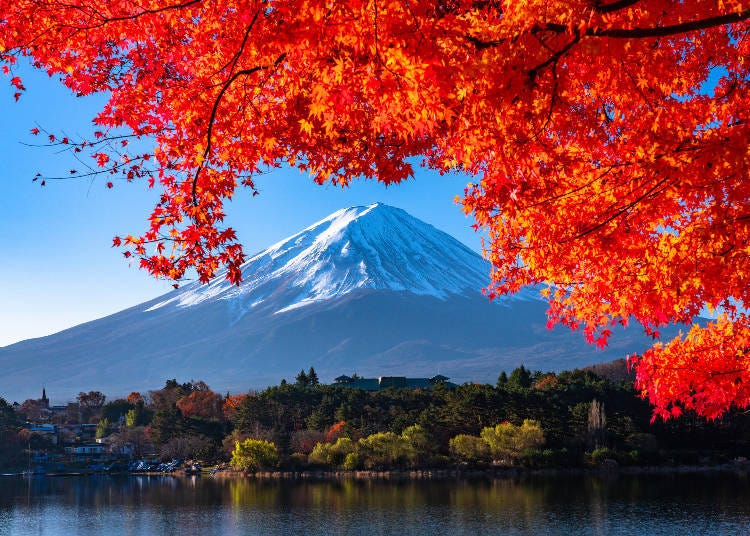
We’ve outlined Japan’s key autumn holidays above, but when planning your trip, be sure to avoid peak crowds so you can fully enjoy the season at a relaxed pace.
Next comes the real highlight of autumn! First is momiji—Japan’s breathtaking autumn foliage. Then there are lively autumn festivals held across the country, along with the Mid-Autumn Moon Viewing, a celebration of harvest and prayers for good fortune. These are essential cultural experiences, so be sure to add them to your itinerary and savor the best of autumn in Japan.
Autumn Foliage in Japan: From Hokkaido to Kansai, Where to See the Best Colors
From late September through November, Japan transforms into a canvas of deep crimson and golden hues. Starting in Hokkaido and moving south to Tokyo, Osaka, and Kyoto, each region offers spectacular foliage at its peak. The prime viewing season falls between late October and November, the perfect time for travelers chasing autumn’s beauty.
In Tokyo, <@Shinjuku Gyoen|a=article:a0003755> is a favorite, where European-style gardens glow with autumn reds, while the ginkgo-lined avenue at Meiji Jingu Gaien shines brilliantly in gold. In Osaka, enjoy a picnic under the maples at <@Osaka Castle Park|a=article:a2000008@>, where the backdrop of the historic castle adds to the magic. For nature lovers, Minoo Park—famous for its Maple Waterfall—is a must-visit hiking spot.
Kyoto remains the ultimate destination for autumn leaves. Eikando, hailed as the city’s top foliage spot, is breathtaking during its night illuminations. Arashiyama’s Togetsukyo Bridge and Tenryu-ji Temple blend the charm of the ancient capital with fiery autumn colors, while Tofuku-ji’s Tsutenkyo Bridge offers sweeping views that feel like walking above a sea of red.
Planning a Trip to See Japan’s Autumn Colors? Don’t Miss These Spots
・Hokkaido: Hokkaido University Ginkgo Avenue, Noboribetsu Hell Valley, Otaru Temiya Park
・Tokyo: Shinjuku Gyoen, Meiji Jingu Gaien Ginkgo Avenue, Rikugien Garden (night illuminations)
・Osaka: Minoo Park Maple Waterfall, Osaka Castle Park, Nagai Botanical Garden
・Kyoto: Eikando, Arashiyama Togetsukyo Bridge, Tofuku-ji Tsutenkyo Bridge, Kiyomizu-dera, Kifune Shrine, Kurama-dera
-
 Hokkaido Autumn Foliage Tour from Sapporo|Jozankei, Hoheikyo, Fruit Picking, Sake Tasting & Otaru Canal
Hokkaido Autumn Foliage Tour from Sapporo|Jozankei, Hoheikyo, Fruit Picking, Sake Tasting & Otaru Canal
Details & Bookings ▶
Photo: KKday -
 Kyoto|Sagano Romantic Train One-Way Ticket (Saga–Kameoka)
Kyoto|Sagano Romantic Train One-Way Ticket (Saga–Kameoka)
Details & Bookings ▶
Photo: KKday -
 Kyoto Autumn Day Tour|Enryaku-ji, Hachiman-bori, Ishi-no-dera & Kyōrinbō Night Lights
Kyoto Autumn Day Tour|Enryaku-ji, Hachiman-bori, Ishi-no-dera & Kyōrinbō Night Lights
Details & Bookings ▶
Photo: KKday -
 Osaka|Arima Autumn Leaves Day Trip with Minoo Park, Katsuo-ji & Zuihō-ji Park
Osaka|Arima Autumn Leaves Day Trip with Minoo Park, Katsuo-ji & Zuihō-ji Park
Details & Bookings ▶
Photo: KKday -
 Tokyo Autumn Foliage Tour|Mt. Takao, Showa Memorial Park & Yomiuriland Lights
Tokyo Autumn Foliage Tour|Mt. Takao, Showa Memorial Park & Yomiuriland Lights
Details & Bookings ▶
Photo: KKday -
 Nagoya Autumn Tour|Eiho-ji Temple, Korankei Maple Valley & Shikizakura Blossoms
Nagoya Autumn Tour|Eiho-ji Temple, Korankei Maple Valley & Shikizakura Blossoms
Details & Bookings ▶
Photo: KKday
Mid-Autumn Festival: Full Moon, Dumplings & the Romance of Autumn Nights

In Japan, the Mid-Autumn Festival is called Jūgoya or Otsukimi, a time-honored tradition of moon viewing and harvest prayers. During the Heian period, aristocrats hosted elegant moon-viewing banquets, composing poetry and drinking sake under the night sky. Over time, the practice spread to common households, becoming a familiar custom of gathering with family and friends.
During Jūgoya, people place pampas grass (susuki) at shrines, temples, or home altars to ward off misfortune, while moon-viewing dumplings (tsukimi dango) are offered in thanks for the year’s blessings and prayers for a bountiful harvest ahead. Seasonal foods like taro, chestnuts, and persimmons are also displayed, symbolizing the gifts of the earth.
Today, moon-viewing events are held across Japan, from traditional shrine ceremonies to modern garden gatherings. For travelers, it’s a unique way to experience the Mid-Autumn Festival with a distinctly Japanese touch.
Autumn Festivals: From Moon Viewing to Jidai Matsuri, Celebrating Japan’s Harvest Traditions
Since ancient times, festivals in Japan have served as moments of unity, carrying the joy of celebrating health and safety together. In autumn, when the air turns crisp, these events often take on even greater vibrancy. They mark a season to reflect on the year’s efforts and harvests, to thank the gods and the land, and to pray for peace and abundance in the year ahead.
With Japan’s wide geography, each region boasts unique autumn festivals, far too many to list in full. Below, we’ve highlighted some of the most iconic ones to help you experience both the excitement of the season and the deep cultural roots of Japan’s festival traditions.
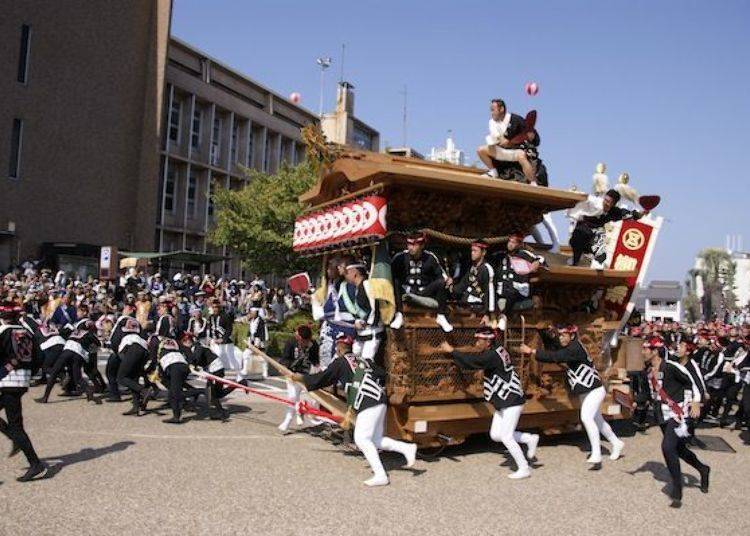
Yamanashi: Yoshida Fire Festival (August 26-27)
The Yoshida Fire Festival, celebrated at the foot of Mt. Fuji from late August to early September, is hailed as one of Japan’s Three Most Unique Festivals. Co-hosted by Kitaguchi Hongu Fuji Sengen Shrine and Suwa Shrine, the two-day event features sacred rituals, portable shrines carried through the streets, and the climactic lighting of towering torches. Weighing over a thousand kilograms, the portable shrines require immense teamwork to bear. On the festival night, giant torches nearly three meters tall are set ablaze, lining the streets with flames in a breathtaking spectacle. The festival is said to pray for protection against Mt. Fuji’s eruptions and for the safety and peace of the community under the gods’ watchful care.
Osaka: Kishiwada Danjiri Matsuri (September 13-14; October 11-12)
When it comes to autumn festivals in Japan, Osaka’s Kishiwada Danjiri Matsuri is not to be missed. The highlight is the enormous wooden festival floats, or danjiri, intricately carved like works of art. Teams of men haul these massive floats at full speed through the streets, making sharp turns that showcase raw strength, beauty in motion, and flawless teamwork. Even as a spectator, the sheer intensity is thrilling. Beyond the spectacle, the festival is also a prayer for a bountiful harvest and community prosperity, making it one of Osaka’s most famous autumn celebrations.
Osaka: Sumiyoshi Taisha Moon-Viewing Festival (October 6)
Sumiyoshi Taisha is one of Osaka’s most important shrines, and each year around the Mid-Autumn Festival it hosts the Kangetsusai Moon-Viewing Festival. The ceremony recreates the elegance of Heian-era moon-viewing banquets, with the sounds of court music (gagaku) and classical poetry filling the air. Offerings of moon-viewing dumplings are placed on altars, while pampas grass and lanterns decorate the shrine grounds, creating a serene atmosphere unlike any other time of year. The festival is both a thanksgiving for the harvest and a prayer for future prosperity and family well-being. In contrast to the fiery energy of Kishiwada Danjiri Matsuri, the Kangetsusai radiates quiet elegance, making it ideal for those who wish to savor Japan’s culture in a more refined way.
Saitama: Kawagoe Festival (October 18)
Known as “Little Edo,” Kawagoe hosts its grandest autumn event each October—the Kawagoe Festival. Originating in 1648, this celebration has a history of over 370 years and is designated an Important Intangible Folk Cultural Asset of Japan. The highlight is the parade of lavishly decorated festival floats. When two floats meet head-on, the thrilling hikkawase begins, as they compete with spirited drumming, flutes, and traditional hayashi music. Visitors are captivated not only by the magnificent spectacle but also by the vibrant festival sounds, making it a powerful blend of history, tradition, and passion.
Kyoto: Jidai Matsuri, One of the City’s Three Great Festivals (October 22)
The Jidai Matsuri, counted among Kyoto’s three great festivals alongside the Gion and Aoi Festivals, is held each October. Designed to showcase over a thousand years of history, it features a magnificent parade of thousands of participants dressed in period costumes. From Heian aristocrats to Sengoku warriors and Meiji-era figures, each era is vividly represented. Watching the procession move through Kyoto’s streets feels like stepping into a living picture scroll, making it an unforgettable experience for first-time visitors.
-
 Ibaraki|Oarai Fireworks & Chōkuro Festival Day Tour
Ibaraki|Oarai Fireworks & Chōkuro Festival Day Tour
Details & Bookings ▶
Photo: KKday -
 Aichi|30th Fire Festival “Shimotsuki Honō no Mai” Day Tour
Aichi|30th Fire Festival “Shimotsuki Honō no Mai” Day Tour
Details & Bookings ▶
Photo: KKday -
 Kyoto|Jidai Matsuri with Tenryu-ji & Arashiyama (From/To Kyoto Station)
Kyoto|Jidai Matsuri with Tenryu-ji & Arashiyama (From/To Kyoto Station)
Details & Bookings ▶
Photo: KKday -
 Seasonal Limited|Yoshida Fire Festival, Mt. Fuji 5th Station & Kawaguchiko Herb Garden (From Shinjuku)
Seasonal Limited|Yoshida Fire Festival, Mt. Fuji 5th Station & Kawaguchiko Herb Garden (From Shinjuku)
Details & Bookings ▶
Photo: KKday -
 Tokyo|Dōkan Festival Parade & Goma Ritual Two-Day Cultural Tour
Tokyo|Dōkan Festival Parade & Goma Ritual Two-Day Cultural Tour
Details & Bookings ▶
Photo: KKday
- Category
*Prices and options mentioned are subject to change.
*Unless stated otherwise, all prices include tax.
Popular Tours & Activitiess
Recommended places for you
-

Kambei Sannomiyahonten
Yakiniku
Kobe, Sannomiya, Kitano
-
Appealing

Rukku and Uohei
Izakaya
Sapporo / Chitose
-

ISHIDAYA Hanare
Yakiniku
Kobe, Sannomiya, Kitano
-

Kanzenkoshitsuyakinikutabehodai Gyugyu Paradise Sannomiya
Yakiniku
Kobe, Sannomiya, Kitano
-
Goods
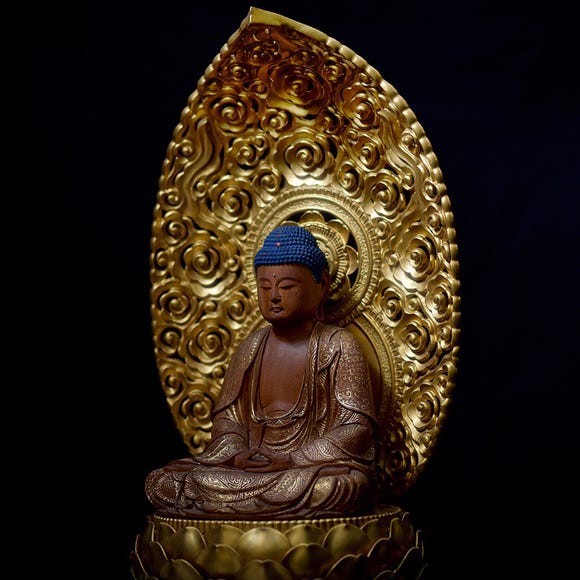
Yoshida Gennojo-Roho Kyoto Buddhist Altars
Gift Shops
Nijo Castle, Kyoto Imperial Palace
-

Jukuseiniku-to Namamottsuarera Nikubaru Italian Nikutaria Sannomiya
Izakaya
Kobe, Sannomiya, Kitano
-

These Tokyo Subway Stamps Are Free, Exclusive, and Weirdly Addictive
by: Guest Contributor
-

Only in Tokyo? A Legendary Manga Artist's New Masterpiece Is Hiding Underground
by: Guest Contributor
-
Ad

[Tokyo, Ueno] Journey to the Sacred Grounds of the Tokugawa Shoguns: Join the "EDO SHOGUN’S LEGACY TRAIL TOUR" – Where Special Access, Modern Art, and Digital Innovation Converge
by: Guest Contributor
-

Make Your Japan Trip Unforgettable! Explore "OSHI MAP" – Now Free and Unlimited
by: Guest Contributor
-

This Winter, Godzilla Takes Over Haneda Airport
by: Guest Contributor
-

Japan’s Shinkansen Is About to Change Travel in an Unexpected Way
by: Guest Contributor
-

Yamagata Prefecture Guide: Destinations, Activities, Travel Advice, Shopping & More
by: Steve Csorgo
-

These 4 Places For Fall Scenery With A Japanese Vibe In Hokkaido Will Take Your Breath Away
-

Planning an Autumn Trip to Kyoto? 5 Things to Know Before Packing Your Travel Bag and Where to See Autumn Foliage!
by: WESTPLAN
-

5 Magical Places to Enjoy Autumn Leaves At Night in Tokyo
-

Popular Food at Universal Studios Japan
by: WESTPLAN
-

Enjoy Autumn Hues in Japan's Wild Frontier: Two-Day Road Trip Itinerary for Mount Daisetsu and Asahikawa (Hokkaido)
by: Hide
- #best sushi japan
- #what to do in odaiba
- #what to bring to japan
- #new years in tokyo
- #best ramen japan
- #what to buy in ameyoko
- #japanese nail trends
- #things to do japan
- #onsen tattoo friendly tokyo
- #daiso
- #best coffee japan
- #best japanese soft drinks
- #best yakiniku japan
- #japanese fashion culture
- #japanese convenience store snacks
























